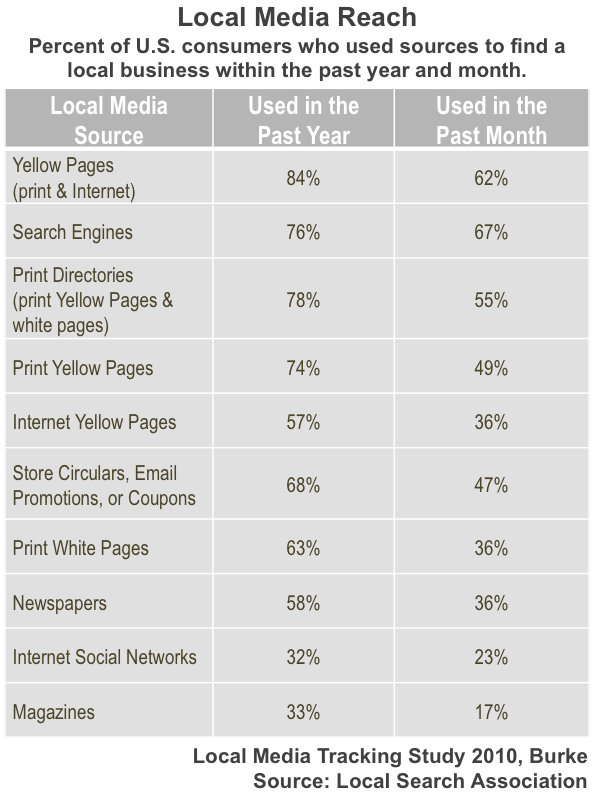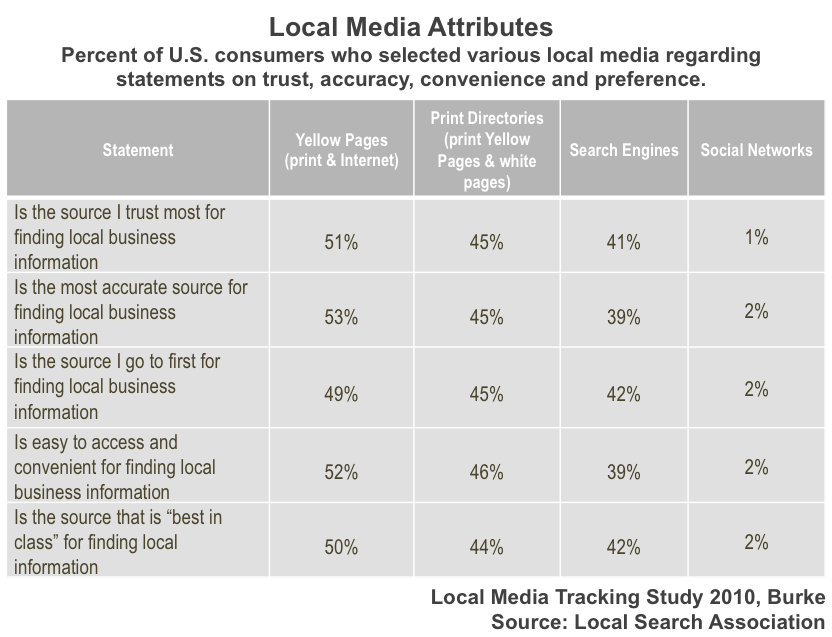Yellow Pages has yielded the top spot for local business lookups to search engines like Google and Bing, but it still holds a significant spot in the local search hierarchy, according to new data released today by the Local Search Association.
The latest “Local Media Tracking Study” shows that search engines rank higher than Yellow Pages (print and digital combined) in monthly reach (67 percent vs. 62 percent), while combined Yellow Pages still has the edge over search in annual reach (84 percent vs. 76 percent). Print Yellow Pages alone, however, has fallen behind search in both annual (78 percent to 74 percent) and monthly (67 percent to 49 percent) reach.
LSA President Neg Norton said in a briefing last week that the study reflects the new direction of the association, which earlier this year changed its name from the Yellow Pages Association.
“This is an example of how the association is changing,” he said. “This is not a Yellow Pages study. It is a more holistic look at the local landscape.”

The “Local Media Tracking Study” was conducted by the research firm Burke. The LSA uses Burke to measure print usage, and comScore for usage data on Internet Yellow Pages. Combining the two sources, Yellow Pages had 16.6 billion references last year, 11 billion print and 5.6 billion online. The print figure was down from 12 billion in 2009.
The study has also found that social media had not yet broken through as a primary source for local search. When respondents were asked to name the source they trusted most in finding local businesses, only 1 percent said “social networks” compared with 41 percent for search engines and 51 percent for Yellow Pages (print and digital combined).
This was the first year that social was included in the study, and it was added in the third quarter last year, so there wasn’t a full year of data. For the 2011 study, the LSA will have a full year’s data on social, which matters if there is a seasonal impact on the use of social media to find local businesses. Regardless, we would expect the social figures to rise substantially this year.

The data on Yellow Pages can be seen as a glass that’s either half empty or half full.
The fact that search has surpassed Yellow Pages in several key measures is concrete evidence that Yellow Pages is no longer the dominant resource for finding local businesses. This is consistent with the longstanding general perception that Yellow Pages has yielded the leadership position to search.
The half-full perspective comes from the fact that despite its decline, Yellow Pages, including print, remains a very large component of local media use, perhaps beyond what the common perception might suggest. Also, the fact that Yellow Pages is still the more trusted resource for local business lookups is a positive datapoint for those in the Yellow Pages business.
Norton’s take on the data is that they show consumers are consulting more sources to make a purchase decision (consistent with what BIA/Kelsey has found in its User View study), particularly around infrequent or considered purchases, which have always been sweet spots for Yellow Pages.
“Despite all the fragmentation, print is holding its own,” he said.
This Post Has 2 Comments
Leave a Reply
You must be logged in to post a comment.

It would be interesting to see how this data breaks out by various demographic data such as age, income and location. It might show whether Neg Norton’s take that consumers are consulting more sources or whether the data is skewed by older deomographic using print with the younger demo using search.
Chris, reach is certainly lowest among those under 34 and in larger markets. It also appears that declines are bigger in suburban areas, suggesting they may be following the path of urban areas, which have already lost a lot of usage. The data mixes telephone and online sample, which might explain a more favorable result for print than a 100% online sample would produce. Not that using both is necessarily bad methology, it may give a more accurate picture. The idea of consulting more choices is something that appears in our data as well.